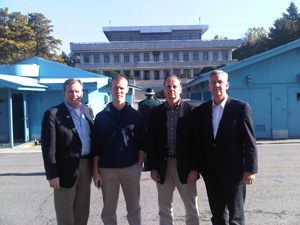Korea is said by some to be more than 5,000 years old. It’s in the heart of that antiquity that our delegation convened in Seoul where we continued a cyber-focused theme in our discussions of the particular security challenges faced here in Korea. While not my first time in this ancient country--the only nation in the world that yet remains divided—it is my first visit since having joined the ranks of the private sector. We landed at the 10 year old Incheon International Airport and experienced first-hand the efficiency that once garnered for it the title of best airport in the world. The speed with which we traversed the island of Incheon, just off the coast of Korea, stood in stark contrast to what General MacArthur experienced when initiating his surprise counterattack here more than 50 years ago during the Korean War.
In 2009, the White House issued what it characterized as “a Joint Vision for the Alliance of the United States of America and the Republic of Korea.” Speaking our of historic relationship, the document observed that “the bonds that underpin our Alliance and our partnership are strengthened and enriched by the close relationships among our citizens” and pledged “to continue programs and efforts to build even closer ties between our societies, including cooperation among business, civic, cultural, academic and other institutions.” OSAC is clearly one of the vehicles through which we are attempting to do just that.
As in other countries we’ve visited much of our time was spent engaging the hospitable members of the U.S. embassy, a somewhat dated building positioned just down the street from one of five royal palaces located here in Seoul. Deputy Chief of Mission, Mark Tokola, and other members of the Embassy staff met with the team and shared a number of interesting insights into Korea—not the least of which included the fact that Korea is one of the most “wired” countries in the world…a fact that becomes immediately apparent as one steps on to a subway and witnesses the fact that most if not all of the passengers can be seen engaged in the use of some electronic device or another.
Korea is committed to the rule of law, has generally good IP protection, and has more free trade agreements than almost anyone. President Obama just signed one between Korea and the U.S.—an action the Korean Parliament must yet ratify. With the support of the major Korean Chaebols, i.e. South Korean business conglomerates…it wouldn’t be surprising if that ratification was soon forthcoming. Like the U.S., Korea is facing a number of significant elections this next year, including the Mayor of Seoul, Parlimentary elections, and that of a new President in 2012. Korea also received news, just a few days before our arrival, that they will host the 2018 Winter Olympic Games. The chosen sites, Pyeongchang--a mountainous city 110 miles east of Seoul, best known for its dried walleye delicacy and as Korea’s largest ski resort—hopes to one day become "the winter sports hub of Asia."
Our formal visit was capped by a meeting of the Seoul Country Council which convened at the Embassy Annex, located within the confines of what is known as the United States Army Garrison Yongsan--headquarters for the U.S. military presence in Korea. (Interesting side note: The garrison previously served as headquarters for the Imperial Japanese Army, during its long years of occupation from 1910 to 1945. Unlike that occupant, the presence of the U.S. military is currently viewed favorably by 89% of the Korean population.) The bulk of the presentations was on cyber related topics and included one made by a representative of the Korean Internet and Security Agency (KISA). If anyone anecdote stood out in my mind it was that which observed that although the iPhone was two years late in arriving in Korea, it already holds the record of the second most prolific use of it.
Our brief visit to Seoul was etched in our memory with the culinary experience of Kimchi, a traditional fermented Korean dish made of seasoned vegetables, and sampling of a famous Korean barbeque.
On the morning of our departure we took a brief detour to the “38th Parallel” for a visit to the Joint Security Area at Pan Mun Jom, where the 1953 Korean Armistice Agreement suspending the Korean War was signed. We stood shoulder to shoulder with the brave young men of Camp Bonifas, a United Nations Command post located 400 meters south of the southern boundary of the Korean Demilitarized Zone (DMZ) as they stare into the face of a yet very hostile “North”. As part of our visit we descended into the third of four discovered tunnels dug by the North under the DMZ. (Reportedly, there were to have been 22.) This one was discovered on October 17, 1978, following a tip from a North Korean defector. The tunnel is about 1,600 m (1,700 yd) long and about 350 m (1,150 ft) below ground and hewed through solid granite.

|
| McClurg, Heminger, Hartung, & Ford |
Next stop…Seattle…and the Pan-Asia Council Meeting. You’re invited to stay “On the Track of OSAC” as we continue to chronicle our travels via this blog. In the meantime continue look for exact dates and times of Country Council meetings at www.OSAC.gov .

